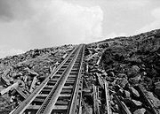
Mount Washington Cog Railway
Encyclopedia
The Mount Washington Cog Railway is the world's first mountain-climbing cog railway
(rack-and-pinion railway). It uses a Marsh rack system to climb Mount Washington
in New Hampshire
, USA
.
The railway ascends the mountain beginning at an elevation of approximately 2700 feet (823 m) above sea level and ending at the summit of Mt. Washington at an elevation of 6288 feet (1,916.6 m). It is the second steepest rack railway in the world with an average grade of over 25% and a maximum grade of 37.41%. The railway is still in operation, using one or two steam locomotive
s and four biodiesel powered locomotives. The train ascends the mountain at 2.8 miles per hour (4.5 km/h) and descends at 4.6 mph (7.4 km/h), although the diesel can go up in as little as 37 minutes. It takes approximately 65 minutes to ascend and 40 minutes to descend. The railway is approximately 3 miles (4.8 km) long.
Most of the Mount Washington Cog Railway is in Thompson and Meserve's Purchase
, with the part of the railway nearest to Mt. Washington's summit being in Sargent's Purchase
.
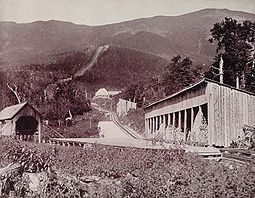 The railway was built by Sylvester Marsh (1803-1884) of Campton
The railway was built by Sylvester Marsh (1803-1884) of Campton
, who came up with the idea while climbing the mountain in 1857. His plan was treated as insane. Local tradition says the state legislature voted permission based on a consensus that harm resulting from operating it was no issue — since the design was attempting the impossible — but benefits were guaranteed: The $5,000 of his own money he put up, and whatever else he could raise, would be spent largely locally, including building the Fabyan House hotel at nearby Fabyan Station to accommodate the expected tourists. The railway is sometimes called "Railway to the Moon" because one state legislator remarked during the proceedings that Marsh should not only be given a charter up Mount Washington but also to the moon
. After developing a prototype
locomotive and a short demonstration section of track, he found investors and started construction.
Despite its incomplete state, the first paying customers rode in 1868; the construction reached the summit in 1869. The early locomotive
s all had vertical boiler
s, like many stationary steam engine
s of the time; the boilers were mounted on trunnion
s allowing them to be held vertically no matter what the gradient of the track. Later designs introduced horizontal boilers, slanted so they remain close to horizontal on the steeply graded track.
Sylvester Marsh died in 1884 and control of the Cog passed to the Concord & Montreal Railroad, which ran it until 1889 when the Boston & Maine Railroad took over.
Control by the Teagues began in 1931 when Col. Henry N. Teague bought the Cog. In 1951 following Col. Teague's death, Arthur S. Teague, the colonel's protégé but no relation, became general manager. Arthur S. Teague gained ownership in 1961. After he died in 1967, the ownership passed to his wife, Ellen Crawford Teague, who ran the Cog as the world's first woman president of a railway. In 1983 Mrs. Teague sold the railway to a group of New Hampshire businessmen. The Cog has been in continuous operation since 1869 with service interruptions only during the World Wars.
In the summer of 2008, the Cog introduced its first diesel locomotive. The late 2000s recession
and the 2000s energy crisis led to fewer passengers, and the Cog sought to cut costs with the diesel, which could make 3 round trips for the cost of one steam train round trip.
The "Devil's shingles" were banned in 1906 after the accidental death of an employee. Later the design of the rack was changed so the old braking mechanism could not grip any more.
, #1 (first named Hero and later Peppersass because of its vertical boiler's resemblance to a pepper sauce bottle) which was used to build the railway was found after being lost for many years as it had been moved about the country and placed on display at many exhibitions. The owners of the railway at the time (the Boston & Maine Railroad) decided to restore Peppersass and make a commemorative trip for the railway's 60th anniversary. During the ascent, however, the locomotive's front axle
broke and the locomotive began descending the mountain at high speed. All but one of its crew jumped to safety (though some suffered broken bones), but one man did not escape and died. Although the locomotive broke into pieces, the boiler did not rupture, and the pieces were later reassembled to reconstruct the locomotive for static display. It is now located at the Cog Railway Base Station.
On September 17, 1967, eight passengers were killed and seventy-two injured when Engine #3 derailed at the Skyline switch about a mile below the summit. The engine rolled off the trestle
while the uncoupled passenger car slid several hundred feet into a large rock. An investigation revealed that the Skyline switch had not been properly configured for the descending train. The railway nonetheless has a solid safety record having taken almost five million people to the summit during its existence.
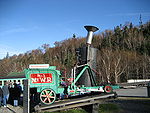 Each train consists of a locomotive pushing a single passenger car up the mountain, and descending the mountain by going backwards. Both locomotive and car were originally equipped with a ratchet and pawl
Each train consists of a locomotive pushing a single passenger car up the mountain, and descending the mountain by going backwards. Both locomotive and car were originally equipped with a ratchet and pawl
mechanism engaged during the climb that prevents any roll-back; during descent, both locomotive and car are braked. Recent improvements in design have replaced the ratchet (gear and pawl mechanism) with sprague clutches and disc brake
assemblies. Most of the locomotives were made by the Manchester Locomotive Works
.
The rack
rail design used is one of Marsh's own invention, using a ladder-like rack with open bar rungs engaged by the teeth of the cog wheel
. This system allows snow and debris to fall through the rack rather than lodge in it. A similar design, called the Riggenbach rack system, was invented by engineer
Niklaus Riggenbach
in Switzerland
at about the same time. The Swiss Consul to the United States visited Marsh while constructing the railway up Mount Washington, and his enthusiastic reports persuaded the Swiss government to commission Riggenbach to build on Rigi Mountain the Vitznau-Rigi-Bahn, opened on May 21, 1871.
Initially, there was no way to pass on the Mount Washington Cog Railway. In 1941, a nine-motion switch
was invented, and two spur sidings
were added, each long enough to divert two up trains so others could pass down, enabling more round trips per day.
In 2004, work was completed replacing the lower Waumbek Switch and Siding with an 1800 feet (548.6 m) passing loop equipped with electric and hydraulicly powered automated switches. These switches are powered by batteries and recharged by solar panels. One switch is located at each end of the loop, allowing ascending and descending trains to pass one another.
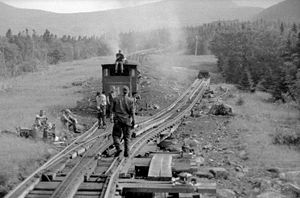 The most common trips on the Cog Railway are between the two main stations, one at the summit and the other adjacent to the operators' logistical and repair base.
The most common trips on the Cog Railway are between the two main stations, one at the summit and the other adjacent to the operators' logistical and repair base.
From 2003 to 2006, "ski trains" ran, stopping at an intermediate station, from which passengers could ski
down to the Base Station.
The Cog Railway track crosses a hiking trail a relatively short distance below the summit of Mount Washington, and some hikers wait for the next train in order to moon
the passengers. This practice is known as "Mooning the Cog
."
Several hikers were arrested for performing this ritual in 2008.
Access to the base station by car is by three possible routes, each culminating with the upper portion of the dead-end Cog Base Road. The advertised, roughly eastbound route uses the Base Road's full length from Bretton Woods
. An especially scenic route, initially southbound from U.S. Highway 2, follows Jefferson Notch Road, a narrow dirt road with hairpin turns; it rises 1500 feet (457.2 m) to the pass, at 3000 feet (914.4 m) above sea level, between Mount Jefferson
in the Presidential Range
and Mount Dartmouth, before descending to its junction with the Base Road. However, in winter, and usually before and after, the Jefferson Notch Road is closed to wheeled vehicles and used primarily by snowmobiles. The initially roughly northbound route from U.S. Highway 302 in Crawford Notch
via Mt. Clinton Road is also closed in the winter to vehicular traffic. Due to the operations of trains all winter beginning in 2004-2005 the Cog Base Road is now plowed and sanded all winter to allow tourists, skiers and employees to access the Base Station.
, nicknamed Cog Smog. The railway is exempted from the state's air-pollution-control law (RSA 125-C:20), which exempts "any steam locomotives and engines or replacements thereof used in connection with the operation of a railroad or railway which were in operation or on order prior to January 1, 1973, and are located entirely within the state."
Each 3 mi (4.8 km) ride burns 1 short ton (0.90718474 t) of coal and consumes 1000 gallons (3,785.4 l) of water.
One steam locomotive was converted to biodiesel
in 2008.
All the new diesel hydraulic locomotives are operated on B20 (20% biodiesel blend) during the summer season. The primary reason the new diesels were built was to reduce the visual pollution
caused by the coal-fired steam locomotives and to increase the length of time that passengers could have at the summit of Mt. Washington.
The Cog Railway also rosters seven wooden coaches.
Rack railway
A rack-and-pinion railway is a railway with a toothed rack rail, usually between the running rails. The trains are fitted with one or more cog wheels or pinions that mesh with this rack rail...
(rack-and-pinion railway). It uses a Marsh rack system to climb Mount Washington
Mount Washington (New Hampshire)
Mount Washington is the highest peak in the Northeastern United States at , famous for dangerously erratic weather. For 76 years, a weather observatory on the summit held the record for the highest wind gust directly measured at the Earth's surface, , on the afternoon of April 12, 1934...
in New Hampshire
New Hampshire
New Hampshire is a state in the New England region of the northeastern United States of America. The state was named after the southern English county of Hampshire. It is bordered by Massachusetts to the south, Vermont to the west, Maine and the Atlantic Ocean to the east, and the Canadian...
, USA
United States
The United States of America is a federal constitutional republic comprising fifty states and a federal district...
.
The railway ascends the mountain beginning at an elevation of approximately 2700 feet (823 m) above sea level and ending at the summit of Mt. Washington at an elevation of 6288 feet (1,916.6 m). It is the second steepest rack railway in the world with an average grade of over 25% and a maximum grade of 37.41%. The railway is still in operation, using one or two steam locomotive
Steam locomotive
A steam locomotive is a railway locomotive that produces its power through a steam engine. These locomotives are fueled by burning some combustible material, usually coal, wood or oil, to produce steam in a boiler, which drives the steam engine...
s and four biodiesel powered locomotives. The train ascends the mountain at 2.8 miles per hour (4.5 km/h) and descends at 4.6 mph (7.4 km/h), although the diesel can go up in as little as 37 minutes. It takes approximately 65 minutes to ascend and 40 minutes to descend. The railway is approximately 3 miles (4.8 km) long.
Most of the Mount Washington Cog Railway is in Thompson and Meserve's Purchase
Thompson and Meserve's Purchase, New Hampshire
Thompson and Meserve's Purchase is a township located in Coos County, New Hampshire, United States. As of the 2010 census, the purchase had a population of 0....
, with the part of the railway nearest to Mt. Washington's summit being in Sargent's Purchase
Sargent's Purchase, New Hampshire
Sargent's Purchase is a township located in Coos County, New Hampshire, United States. As of the 2010 census, the purchase had a total population of 3....
.
History

Campton, New Hampshire
Campton is a town in Grafton County, New Hampshire, United States. The population was 3,333 at the 2010 census. Campton, which includes the villages of Blair, Campton Hollow, Lower Campton and West Campton, is home to Blair State Forest and Livermore Falls State Forest...
, who came up with the idea while climbing the mountain in 1857. His plan was treated as insane. Local tradition says the state legislature voted permission based on a consensus that harm resulting from operating it was no issue — since the design was attempting the impossible — but benefits were guaranteed: The $5,000 of his own money he put up, and whatever else he could raise, would be spent largely locally, including building the Fabyan House hotel at nearby Fabyan Station to accommodate the expected tourists. The railway is sometimes called "Railway to the Moon" because one state legislator remarked during the proceedings that Marsh should not only be given a charter up Mount Washington but also to the moon
Moon
The Moon is Earth's only known natural satellite,There are a number of near-Earth asteroids including 3753 Cruithne that are co-orbital with Earth: their orbits bring them close to Earth for periods of time but then alter in the long term . These are quasi-satellites and not true moons. For more...
. After developing a prototype
Prototype
A prototype is an early sample or model built to test a concept or process or to act as a thing to be replicated or learned from.The word prototype derives from the Greek πρωτότυπον , "primitive form", neutral of πρωτότυπος , "original, primitive", from πρῶτος , "first" and τύπος ,...
locomotive and a short demonstration section of track, he found investors and started construction.
Despite its incomplete state, the first paying customers rode in 1868; the construction reached the summit in 1869. The early locomotive
Locomotive
A locomotive is a railway vehicle that provides the motive power for a train. The word originates from the Latin loco – "from a place", ablative of locus, "place" + Medieval Latin motivus, "causing motion", and is a shortened form of the term locomotive engine, first used in the early 19th...
s all had vertical boiler
Boiler
A boiler is a closed vessel in which water or other fluid is heated. The heated or vaporized fluid exits the boiler for use in various processes or heating applications.-Materials:...
s, like many stationary steam engine
Steam engine
A steam engine is a heat engine that performs mechanical work using steam as its working fluid.Steam engines are external combustion engines, where the working fluid is separate from the combustion products. Non-combustion heat sources such as solar power, nuclear power or geothermal energy may be...
s of the time; the boilers were mounted on trunnion
Trunnion
A trunnion is a cylindrical protrusion used as a mounting and/or pivoting point. In a cannon, the trunnions are two projections cast just forward of the centre of mass of the cannon and fixed to a two-wheeled movable gun carriage...
s allowing them to be held vertically no matter what the gradient of the track. Later designs introduced horizontal boilers, slanted so they remain close to horizontal on the steeply graded track.
Sylvester Marsh died in 1884 and control of the Cog passed to the Concord & Montreal Railroad, which ran it until 1889 when the Boston & Maine Railroad took over.
Control by the Teagues began in 1931 when Col. Henry N. Teague bought the Cog. In 1951 following Col. Teague's death, Arthur S. Teague, the colonel's protégé but no relation, became general manager. Arthur S. Teague gained ownership in 1961. After he died in 1967, the ownership passed to his wife, Ellen Crawford Teague, who ran the Cog as the world's first woman president of a railway. In 1983 Mrs. Teague sold the railway to a group of New Hampshire businessmen. The Cog has been in continuous operation since 1869 with service interruptions only during the World Wars.
In the summer of 2008, the Cog introduced its first diesel locomotive. The late 2000s recession
Late 2000s recession
The late-2000s recession, sometimes referred to as the Great Recession or Lesser Depression or Long Recession, is a severe ongoing global economic problem that began in December 2007 and took a particularly sharp downward turn in September 2008. The Great Recession has affected the entire world...
and the 2000s energy crisis led to fewer passengers, and the Cog sought to cut costs with the diesel, which could make 3 round trips for the cost of one steam train round trip.
Devil's shingle
Since the early days of the railway's construction the workers wanted to minimize time when climbing and descending the ramp, so they invented slideboards fitting over the cog rack and providing enough room for themselves and their tools. These boards – no two were exactly alike – were approximately 90 cm (35.4 in) long by 25 cm (9.8 in) wide, made of wood with hand-forged iron and with two long hardwood handles usually attached at the down-mountain end. Common times for the descent of the mountain using these boards were about 15 minutes. The record was 2:45, an average speed above 100 km/h (62.1 mph).The "Devil's shingles" were banned in 1906 after the accidental death of an employee. Later the design of the rack was changed so the old braking mechanism could not grip any more.
Accidents
The first of two major accidents in the railway's history occurred in 1929. The first locomotiveLocomotive
A locomotive is a railway vehicle that provides the motive power for a train. The word originates from the Latin loco – "from a place", ablative of locus, "place" + Medieval Latin motivus, "causing motion", and is a shortened form of the term locomotive engine, first used in the early 19th...
, #1 (first named Hero and later Peppersass because of its vertical boiler's resemblance to a pepper sauce bottle) which was used to build the railway was found after being lost for many years as it had been moved about the country and placed on display at many exhibitions. The owners of the railway at the time (the Boston & Maine Railroad) decided to restore Peppersass and make a commemorative trip for the railway's 60th anniversary. During the ascent, however, the locomotive's front axle
Axle
An axle is a central shaft for a rotating wheel or gear. On wheeled vehicles, the axle may be fixed to the wheels, rotating with them, or fixed to its surroundings, with the wheels rotating around the axle. In the former case, bearings or bushings are provided at the mounting points where the axle...
broke and the locomotive began descending the mountain at high speed. All but one of its crew jumped to safety (though some suffered broken bones), but one man did not escape and died. Although the locomotive broke into pieces, the boiler did not rupture, and the pieces were later reassembled to reconstruct the locomotive for static display. It is now located at the Cog Railway Base Station.
On September 17, 1967, eight passengers were killed and seventy-two injured when Engine #3 derailed at the Skyline switch about a mile below the summit. The engine rolled off the trestle
Trestle
A trestle is a rigid frame used as a support, especially referring to a bridge composed of a number of short spans supported by such frames. In the context of trestle bridges, each supporting frame is generally referred to as a bent...
while the uncoupled passenger car slid several hundred feet into a large rock. An investigation revealed that the Skyline switch had not been properly configured for the descending train. The railway nonetheless has a solid safety record having taken almost five million people to the summit during its existence.
Mechanical design

Ratchet (device)
A ratchet is a device that allows continuous linear or rotary motion in only one direction while preventing motion in the opposite direction. Because most socket wrenches today use ratcheting handles, the term "ratchet" alone is often used to refer to a ratcheting wrench, and the terms "ratchet"...
mechanism engaged during the climb that prevents any roll-back; during descent, both locomotive and car are braked. Recent improvements in design have replaced the ratchet (gear and pawl mechanism) with sprague clutches and disc brake
Disc brake
The disc brake or disk brake is a device for slowing or stopping the rotation of a wheel while it is in motion.A brake disc is usually made of cast iron, but may in some cases be made of composites such as reinforced carbon–carbon or ceramic matrix composites. This is connected to the wheel and/or...
assemblies. Most of the locomotives were made by the Manchester Locomotive Works
Manchester Locomotive Works
Manchester Locomotive Works was a manufacturing company located in Manchester, New Hampshire, that built steam locomotives in the 19th century. The first locomotive they built was for the Chicago, Burlington and Quincy Railroad in March 1855. In 1901, Manchester and seven other locomotive...
.
The rack
Rack and pinion
A rack and pinion is a type of linear actuator that comprises a pair of gears which convert rotational motion into linear motion. A circular gear called "the pinion" engages teeth on a linear "gear" bar called "the rack"; rotational motion applied to the pinion causes the rack to move, thereby...
rail design used is one of Marsh's own invention, using a ladder-like rack with open bar rungs engaged by the teeth of the cog wheel
Gear
A gear is a rotating machine part having cut teeth, or cogs, which mesh with another toothed part in order to transmit torque. Two or more gears working in tandem are called a transmission and can produce a mechanical advantage through a gear ratio and thus may be considered a simple machine....
. This system allows snow and debris to fall through the rack rather than lodge in it. A similar design, called the Riggenbach rack system, was invented by engineer
Engineer
An engineer is a professional practitioner of engineering, concerned with applying scientific knowledge, mathematics and ingenuity to develop solutions for technical problems. Engineers design materials, structures, machines and systems while considering the limitations imposed by practicality,...
Niklaus Riggenbach
Niklaus Riggenbach
Niklaus Riggenbach was the inventor of the Riggenbach rack system and the counter-pressure brake. He was also an engineer and locomotive builder....
in Switzerland
Switzerland
Switzerland name of one of the Swiss cantons. ; ; ; or ), in its full name the Swiss Confederation , is a federal republic consisting of 26 cantons, with Bern as the seat of the federal authorities. The country is situated in Western Europe,Or Central Europe depending on the definition....
at about the same time. The Swiss Consul to the United States visited Marsh while constructing the railway up Mount Washington, and his enthusiastic reports persuaded the Swiss government to commission Riggenbach to build on Rigi Mountain the Vitznau-Rigi-Bahn, opened on May 21, 1871.
Initially, there was no way to pass on the Mount Washington Cog Railway. In 1941, a nine-motion switch
Railroad switch
A railroad switch, turnout or [set of] points is a mechanical installation enabling railway trains to be guided from one track to another at a railway junction....
was invented, and two spur sidings
Rail siding
A siding, in rail terminology, is a low-speed track section distinct from a running line or through route such as a main line or branch line or spur. It may connect to through track or to other sidings at either end...
were added, each long enough to divert two up trains so others could pass down, enabling more round trips per day.
In 2004, work was completed replacing the lower Waumbek Switch and Siding with an 1800 feet (548.6 m) passing loop equipped with electric and hydraulicly powered automated switches. These switches are powered by batteries and recharged by solar panels. One switch is located at each end of the loop, allowing ascending and descending trains to pass one another.
Modern operations

From 2003 to 2006, "ski trains" ran, stopping at an intermediate station, from which passengers could ski
Ski
A ski is a long, flat device worn on the foot, usually attached through a boot, designed to help the wearer slide smoothly over snow. Originally intended as an aid to travel in snowy regions, they are now mainly used for recreational and sporting purposes...
down to the Base Station.
The Cog Railway track crosses a hiking trail a relatively short distance below the summit of Mount Washington, and some hikers wait for the next train in order to moon
Mooning
Mooning is the act of displaying one's bare buttocks by removing clothing, e.g., by lowering the backside of one's trousers and underpants, usually bending over, whether also exposing the genitals or not...
the passengers. This practice is known as "Mooning the Cog
Mooning the Cog
Mooning the Cog is a tradition in which hikers bare their buttocks to the Cog Railway on Mount Washington, the highest peak in New Hampshire. Most commonly it is done by thru-hikers, as they pass by on the Appalachian Trail. It is a twenty- to thirty-year-old tradition, in which, as the train...
."
Several hikers were arrested for performing this ritual in 2008.
Access to the base station by car is by three possible routes, each culminating with the upper portion of the dead-end Cog Base Road. The advertised, roughly eastbound route uses the Base Road's full length from Bretton Woods
Bretton Woods, New Hampshire
Bretton Woods is an area within the town of Carroll, New Hampshire, USA, whose principal points of interest are three leisure and recreation facilities...
. An especially scenic route, initially southbound from U.S. Highway 2, follows Jefferson Notch Road, a narrow dirt road with hairpin turns; it rises 1500 feet (457.2 m) to the pass, at 3000 feet (914.4 m) above sea level, between Mount Jefferson
Mount Jefferson (New Hampshire)
Mount Jefferson is located in Coos County, New Hampshire, and is the third highest mountain in the state. The mountain is named after Thomas Jefferson, the third president of the United States, and is part of the Presidential Range of the White Mountains...
in the Presidential Range
Presidential Range
The Presidential Range is a mountain range located in the White Mountains of the U.S. state of New Hampshire. Containing the highest peaks of the Whites, its most notable summits are named for American Presidents, followed by prominent public figures of the 18th and 19th centuries.Mt...
and Mount Dartmouth, before descending to its junction with the Base Road. However, in winter, and usually before and after, the Jefferson Notch Road is closed to wheeled vehicles and used primarily by snowmobiles. The initially roughly northbound route from U.S. Highway 302 in Crawford Notch
Crawford Notch
Crawford Notch is the steep and narrow gorge of the Saco River in the White Mountains of New Hampshire, located almost entirely within the town of Hart's Location...
via Mt. Clinton Road is also closed in the winter to vehicular traffic. Due to the operations of trains all winter beginning in 2004-2005 the Cog Base Road is now plowed and sanded all winter to allow tourists, skiers and employees to access the Base Station.
Environmental concerns
The locomotives on the railway generate large amounts of smokeSmoke
Smoke is a collection of airborne solid and liquid particulates and gases emitted when a material undergoes combustion or pyrolysis, together with the quantity of air that is entrained or otherwise mixed into the mass. It is commonly an unwanted by-product of fires , but may also be used for pest...
, nicknamed Cog Smog. The railway is exempted from the state's air-pollution-control law (RSA 125-C:20), which exempts "any steam locomotives and engines or replacements thereof used in connection with the operation of a railroad or railway which were in operation or on order prior to January 1, 1973, and are located entirely within the state."
Each 3 mi (4.8 km) ride burns 1 short ton (0.90718474 t) of coal and consumes 1000 gallons (3,785.4 l) of water.
One steam locomotive was converted to biodiesel
Biodiesel
Biodiesel refers to a vegetable oil- or animal fat-based diesel fuel consisting of long-chain alkyl esters. Biodiesel is typically made by chemically reacting lipids with an alcohol....
in 2008.
All the new diesel hydraulic locomotives are operated on B20 (20% biodiesel blend) during the summer season. The primary reason the new diesels were built was to reduce the visual pollution
Visual pollution
Visual pollution is the term given to unattractive and man-made visual elements of a vista, a landscape, or any other thing that a person does not feel comfortable to look at. Visual pollution is an aesthetic issue, referring to the impacts of pollution that impair one's ability to enjoy a vista or...
caused by the coal-fired steam locomotives and to increase the length of time that passengers could have at the summit of Mt. Washington.
Locomotives in existence
| Number | Name | Image | Builder | Type | Date | Notes | |
|---|---|---|---|---|---|---|---|
| 1 | Peppersass |  |
Campbell, Whittier and Company | Steam locomotive Steam locomotive A steam locomotive is a railway locomotive that produces its power through a steam engine. These locomotives are fueled by burning some combustible material, usually coal, wood or oil, to produce steam in a boiler, which drives the steam engine... |
1866 | World's first cog locomotive, originally named Hero. Last operated in 1929, and is now on display at Marshfield Station Marshfield Station Marshfield Station is located in the township of Thompson and Meserve's Purchase, at the base of the Mount Washington Cog Railway in New Hampshire, USA. It was formerly a transfer point from passenger train service to the cog train taking tourists to the hotels at the summit... . |
|
| 1 | Mt. Washington | Manchester Locomotive Works Manchester Locomotive Works Manchester Locomotive Works was a manufacturing company located in Manchester, New Hampshire, that built steam locomotives in the 19th century. The first locomotive they built was for the Chicago, Burlington and Quincy Railroad in March 1855. In 1901, Manchester and seven other locomotive... |
Steam locomotive | 1883 | Was the first #7 Falcon; renumbered to 1 following rebuilding after the 1895 fire. Renamed Mt. Washington after 1931. Currently stored out of service at the shops. | ||
| 2 | Ammonoosuc |  |
Manchester Locomotive Works | Steam locomotive | 1875 | Was second #4 Atlas; renumbered to 2 following rebuilding after the 1895 fire. Named Ammonoosuc after 1931. | |
| 3 | Agiocochook | 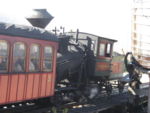 |
Manchester Locomotive Works | Steam locomotive | 1883 | Originally #2 of the Green Mountain Cog Railway Green Mountain Cog Railway The Green Mountain Cog Railway was a narrow gauge mountain railway built to carry tourists to the top of Green Mountain on Mount Desert Island in Maine.- History :... . Was the third #5, not named; became the third #3 in 1934. Renamed Agiocochook in 1995/96. Currently stored serviceable outside the shops. |
|
| 4 | Chocorua | [] | Manchester Locomotive Works | Steam locomotive | 1883 | Originally #1 of the Green Mountain Cog Railway Green Mountain Cog Railway The Green Mountain Cog Railway was a narrow gauge mountain railway built to carry tourists to the top of Green Mountain on Mount Desert Island in Maine.- History :... . Originally named "Summit" Renamed Chocorua in 1996/97. Currently has the cab and tender of #8. There is a possibility of this engine becoming a static display in the nearby town in Twin Mountain. Currently stored serviceable outside the shops. |
|
| 6 | Kancamagus |  |
Manchester Locomotive Works | Steam locomotive | 1874 | Originally built as first #6 Tip-Top with vertical boiler. Rebuilt into second #6 in 1878 with horizontal boiler. Was named Great Gulf Great Gulf The Great Gulf is a glacial cirque, or amphitheater-like valley head formed from a glacier by erosion, located in the White Mountains of New Hampshire... . Currently stored serviceable inside the shops. |
|
| 8 | Moosilauke |  |
Mt. Washington Cog Railway Shop | Steam locomotive | 1983 | Built in 1983 by Mike Kenly at the Cog Shop. At the time was the world's newest steam locomotive. In 2008 a major boiler overhaul was underway when the project was scrapped in favor of building 2 new diesel locomotives. The cab and tender of #8 Tip-Top/Moosilauke now rides on #4 Summit/Chocourua. Currently stored out of service outside the shops. | |
| 9 | Waumbek | Manchester Locomotive Works | Steam locomotive | 1908 | First horizontal boilered engine to have the cab on the same plane as the boiler. For a short time, this locomotive burned biodiesel Biodiesel Biodiesel refers to a vegetable oil- or animal fat-based diesel fuel consisting of long-chain alkyl esters. Biodiesel is typically made by chemically reacting lipids with an alcohol.... , but was reconverted to coal. |
||
| 10 | Kroflite | 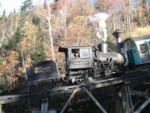 |
Mt. Washington Cog Railway Shop | Steam locomotive | 1972 | Uses a larger, welded boiler built by Munroe Boiler. Has the cab tilted on the same plane as the boiler. Converted to burn oil for a short time and converted back to coal. Was named the Col. Teague. Currently stored serviceable inside the shops. | |
| M-1 | Wajo Nanatassis | 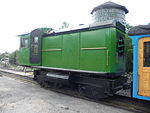 |
Mt. Washington Cog Railway Shop | Diesel locomotive Diesel locomotive A diesel locomotive is a type of railroad locomotive in which the prime mover is a diesel engine, a reciprocating engine operating on the Diesel cycle as invented by Dr. Rudolf Diesel... |
2008 | First diesel-hydraulic locomotive. Powered by biodiesel (B20). | |
| M-2 | Algonquin | Mt. Washington Cog Railway Shop | Diesel locomotive | 2009 | Second diesel-hydraulic locomotive. Powered by biodiesel (B20) | ||
| M-3 | Abenaki | Mt. Washington Cog Railway Shop | Diesel locomotive | 2009 | Third diesel-hydraulic locomotive. Powered by biodiesel (B20) | ||
| M-4 | Agiocochook | Mt. Washington Cog Railway Shop | Diesel locomotive | 2010 or 11 | Fourth diesel-hydraulic locomotive, Powered by biodiesel (B20) |
The Cog Railway also rosters seven wooden coaches.
See also
- Manitou and Pike's Peak RailwayManitou and Pike's Peak RailwayThe Manitou and Pike's Peak Railway is an Abt rack system cog railway in Colorado, USA, climbing the well-known mountain Pikes Peak. The base station is in Manitou Springs, Colorado near Colorado Springs....
- One of America's other cog railways. There are 3 cog railways total in the United States. - Heritage railwayHeritage railwaythumb|right|the Historical [[Khyber train safari|Khyber Railway]] goes through the [[Khyber Pass]], [[Pakistan]]A heritage railway , preserved railway , tourist railway , or tourist railroad is a railway that is run as a tourist attraction, in some cases by volunteers, and...
- List of heritage railways
- NH Historical Marker # 45: Cog Railway
- Mount Washington Auto RoadMount Washington Auto RoadThe Mount Washington Auto Road is a toll road that extends from New Hampshire Route 16 in Pinkham Notch to the summit of Mount Washington in the White Mountains of the U.S. state of New Hampshire. The road climbs from an altitude of at the bottom to at the top, an average gradient of 11.6%...
- Conway Scenic RailroadConway Scenic RailroadThe Conway Scenic Railroad is a heritage railway in North Conway, New Hampshire. The railroad operates over two historic railway routes: a line from North Conway to Conway that was formerly part of the Conway Branch of the Boston and Maine Railroad, and a line from North Conway through Crawford...
External links
- Mount Washington Cog Railway official website
- Mount Washington Cog Railway history and locomotive roster
- Mount Washington Cog Railway photos
- Mount Washington Railway Company - Historical Timeline
- "Among the Clouds" by John H. Ackerman, American Heritage Magazine, April 1968, Volume 19, Issue 3
- ASME/ASCE 1962 designation of Mount Washington Cog Railway as a National Historic Mechanical and Civil Engineering Landmark

